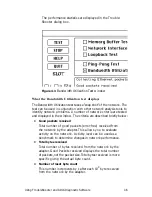
A-4
Technical Specifications
You may find the following tips useful.
❏
10BaseT
The wiring normally called for in 10BaseT is 26 to 22 AWG,
which corresponds to the wire gauge of telephone twisted-
pair cables. You need two pairs of wiring for each node.
Before you think seriously about using your existing phone
wiring for an Ethernet network, be aware that older cabling
may not be of sufficient quality to support the full 100 meters
between a device and the hub.
❏
When wiring 10BaseT connections, take precautions against
splitting pairs. Be sure you maintain the same color mates for
each pair used within the cable. If you don’t follow a com-
mon color pairing, you can mix up the wires preventing the
Ethernet signal from being transmitted.
❏
Be sure to check any cabling you plan to use. Older cabling
may not be of adequate quality to support 100 meters
between a device and the hub.
❏
When subdividing cable segments, do not randomly pick any
length of cable. The IEEE recommends that Ethernet coaxial
cable be subdivided at lengths of 23.4 meters (76.8 feet), or
multiples of that length, in order to minimize internal signal
reflections. These reflections reduce the signal strength for
large networks. On small networks, such as those covering a
single floor of a building, these reflections probably wonnn’t
cause problems.
❏
You may want to install a wiring system in your building, or
you may already have one, that allows you to run a 10BaseT
cable to a wall jack.
Connector Pin-outs
AAUI Connector
The AAUI is a 14-pin connector used in the Apple Ethernet Cabling
System and the Asanté FriendlyNet system as a universal interface to
various external transceiver units (MAUs). The Asanté FriendlyNet
media adapters connect to the AAUI Ethernet port on the Macintosh
Quadras, Centris 610 or Centris 650 with built-in Ethernet and Laser-
Writer IIg printers.
MacConi Appendix A Page 4 Friday, August 23, 1996 10:06 AM



































